What’s Up?
For the first time in as long as I can remember, I am currently laptop-less. I sent my MackBook Pro M1 to Memphis, TN by Fed-Ex on Monday. As I never look at or work my images on a desktop computer, I will be keeping everything from my morning shooting sessions on Delkin Devices 960GB BLACK CFexpress Type A 4.0 Memory Cards, one in each of my two Sony a-1 ii bodies. I am hoping to get laptop back on Thursday or Friday.
If you need to get in touch, please shoot me an e-mail to samandmayasgrandpa@att.net (and please BCC birdsasartstaff@gmail.com) and/or or call or text me at 863-221-2372.
Conditions on Monday morning were perfect but I photographed only a single bird, a one year old Tricolored Heron. I kept only two images.
Today is Tuesday 22 July 2025 and I will be heading down to the lake early to see if I can make a good image or two. Whatever you opt to do, I hope that you too choose to have a wonderful and productive day and that you have fun too. Do remember that happiness is a choice — Byron Katie, The Work.Com.
If an item — a Delkin flash card, a Levered-clamp FlexShooter Pro, or a Wimberley lens plate — for example, that is available from B&H and/or Bedfords, is also available in the BAA Online Store, it would be great, and greatly appreciated, if you would opt to purchase from us. We will match any price. Please remember also to use my B&H affiliate links or to earn 3% cash back at Bedfords by using the BIRDSASART discount code at checkout for your major gear purchases. Doing either often earns you free guides and/or discounts. And always earns my great appreciation.
Nickerson Beach Summer Bird Photography
There are several thousand pairs of beach nesting birds at Nickerson Beach every summer including Common Terns, Black Skimmers, American Oystercatchers, and Piping Plover. Nearly all of the terns and skimmers are in one of two colonies that are about 400 yards apart. There are lots of chicks and tons of flight photography. Not to mention predation. Viewing good images is a great way to improve your bird photography. There are a few good ones in this 21 minute video. Enjoy. Below are two more of my favorite Nickerson Beach photos and information on joining me there this summer.
|
|
Summer bird photography at Nickerson Beach is excellent. |
Nickerson Beach 2025 Educational Opportunities
Please note that prices for both the IPTs and the ITF sessions have been reduced in an effort to attract new blood.
Nickerson Beach 3 Day Mini IPT: WED AUG 6 afternoon thru the morning session on SAT AUG 9, 2025: $1899.00.
Three afternoon sessions, three morning sessions, two brunches with Image Review & Photoshop sessions. AirBnB lodging and rides with the leader possible. Please get in touch with questions or to register with an e-mail to samandmayasgrandpa@att.net and please copy birdsasartstaff@gmail.com) just to be sure. It looks as if I will have access to webmail on one of the two office computers.
|
|
Breeding Black Skimmers, Common Terns, and American Oystercatchers with young. |
Nickerson Beach 4-Day Instructional Photo-Tour (IPT): MON AUG 25 afternoon thru the morning session on FRI AUG 29, 2025: $2299.00.
Four afternoon sessions, Four morning sessions, three brunches with Image Review & Photoshop sessions. AirBnB lodging and rides with the leader possible. Please get in touch with questions or to register with an e-mail to samandmayasgrandpa@att.net and please copy birdsasartstaff@gmail.com) just to be sure. It looks as if Will have access to webmail on one of the two office computers.
|
|
Breeding Black Skimmers, Common Terns, and American Oystercatchers with young. |
Morning BAA In-the-Field Instructional Sessions (ITFIS) followed by brunch and an Image Review & Photoshop session: $449.00/per session
Available dates: AUG 10-31, SEPT 1-5, 2025. Please get in touch with questions or to register with an e-mail to samandmayasgrandpa@att.net and please copy birdsasartstaff@gmail.com) just to be sure. It looks as if I will have access to webmail on one of the two office computers.
Afternoon BAA In-the-Field Instructional Sessions (ITFIS): $299.00/session.
Available dates: AUG 10-15 & 17-31, SEPT 3-5, 2025. Please get in touch with questions or to register with an e-mail to samandmayasgrandpa@att.net and please copy birdsasartstaff@gmail.com) just to be sure. It looks as if I will have access to webmail on one of the two office computers.
Morning and afternoon sessions may be combined and multiple days of instruction are feasible.
|
|
Morning In the Field Instruction at the East Pond at Jamaica Bay Wildlife Refuge may be available — 7/21-22/25. |
Some of What You Will Learn on a Nickerson Beach IPT
- 1- The basics and fine points of digital exposure; how to get the right exposure every time after making a single test exposure (or before if you are using SONY gear).
- 2- How and why to work in Manual mode (even if you’re scared of it).
- 3- How to approach free and wild birds without disturbing them.
- 4- Lots about bird behavior and how to use that knowledge to help you create better images.
- 6- To spot the good and great situations and to choose the best perspective.
- 7- To see, evaluate, and understand the light.
- 8- To design pleasing images by mastering your camera’s AF system.
- 9- And perhaps most importantly, to evaluate wind and sky conditions and understand how they combine to affect bird photography. You will learn where and when to be (and why).
- 10- More than you could ever imagine.
|
|
|
This image was created on 2 August 2024 at Nickerson Beach, Lido Beach, Long Island, NY. Seated on dry sand, I used the Robus RC-5570 Vantage Series 3 Carbon Fiber Tripod/Levered-Clamp FlexShooter Pro-mounted Sony FE 600mm f/4 GM OSS lens, the Sony FE 2.0x Teleconverter, and The One, the Sony Alpha 1 Mirrorless Digital Camera). The exposure was determined via Zebra technology with ISO on the thumb dial. ISO 1250. 1/1250 sec. at f/8 (wide open) in Manual mode. When evaluated in RawDigger, the raw file brightness was determined to be dead solid perfect. AWB at 7:14:06am on a sunny morning. Tracking: Expand Spot/AF-C with Bird-Eye/Face Detection performed perfectly. Click on the image to enjoy the high-res version. Be sure to click on the image to enjoy a high-res version. Image #1: Common Tern — large chick begging |
Young Common Terns
In August, there are usually lot of young Common Terns around. There may still be some relatively small chicks. In addition, there are lots of large chicks, and lots of flying birds of the year, the latter usually four to five weeks old. The parents continue to feed the young for a period after fledging, typically for several months. Once they are flying, they are incredibly handsome.
There are four more young commons in the first, second, and last composites above. Each is at a slightly different stage of development. Each of them is quite handsome making them a treat to photograph.
|
|
|
This image was created on 13 August 2023 at Nickerson Beach, Lido Beach, Long Island, NY. Seated on dry sand, I used the Robus RC-5570 Vantage Series 3 Carbon Fiber Tripod/Levered-Clamp FlexShooter Pro-mounted Sony FE 600mm f/4 GM OSS lens, with the Sony FE 1.4x Teleconverter, and The One, the Sony Alpha 1 Mirrorless Digital Camera.. ISO 1600. The exposure was determined by Zebras with ISO on the rear wheel: 1/1000 second at f/5.6 (wide open) in Manual mode. RawDigger showed that the exposure was perfect. AWB at 7:19:00am on hazy sunny morning. Tracking: Zone/AF-C with Bird-Eye/Face Detection performed perfectly. Click on the image to enjoy the high-res version. Image #2: Just fledged Common Tern in fresh juvenal plumage with Atlantic Silversides |
Why Not Flat on the Ground?
If I had flattened the tripod and gotten much lower, the out of focus adult skimmers in the background would have become very distracting. Would you have eliminated them completely from Image #2?
|
|
|
This image was created on 10 August 2024 at Nickerson Beach, Lido Beach, Long Island, NY. Seated on dry sand, I used the handheld Sony FE 300mm f/2.8 GM OSS lens with the Sony FE 2x Teleconverter and The One, the Sony Alpha 1 Mirrorless Digital Camera). The exposure was determined via Zebra technology with ISO on the Thumb Dial. ISO 1250. 1/4000 sec. at f/5.6 (wide open) in Manual mode. When evaluated in RawDigger, the raw file brightness was determined to be dead-solid perfect (ho hum). AWB at 6:42:25pm on a then sunny morning. Zone/AF-C with Bird Face/Eye detection enabled performed to perfection. Be sure to click on the image to enjoy a high-res version. Image #3: Black Skimmer fledgling standing on sand ridge |
Young Black Skimmers
The skimmers have enjoyed productive seasons for the past several summers, usually producing more than 2,000 young skimmers. Like the young terns, the young skimmers that have begun to fly are quite handsome. One of the challenges of being a young skimmer is to avoid becoming breakfast for a Great Black-backed Gull. I have been loving using the lightweight 300mm f/2.8 GM lens with either teleconverter when photographing beach nesting birds.
Typos
With all blog posts, feel free to e-mail or to leave a comment regarding any typos or errors.

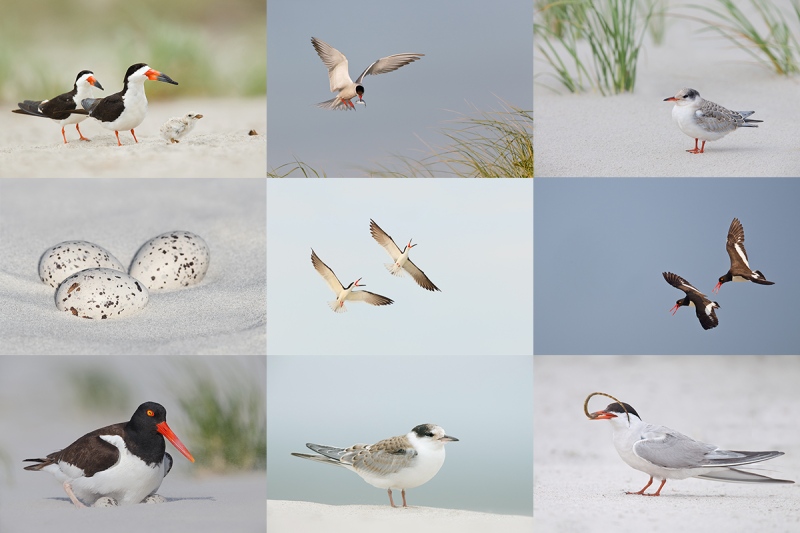
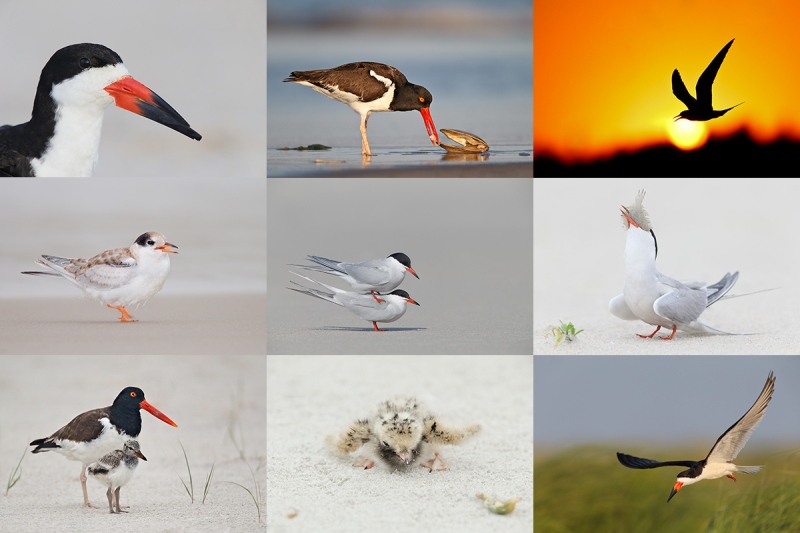
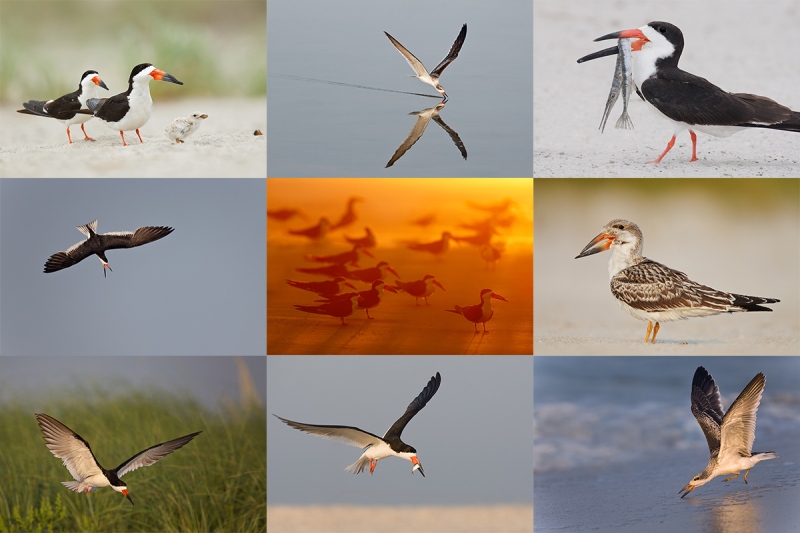
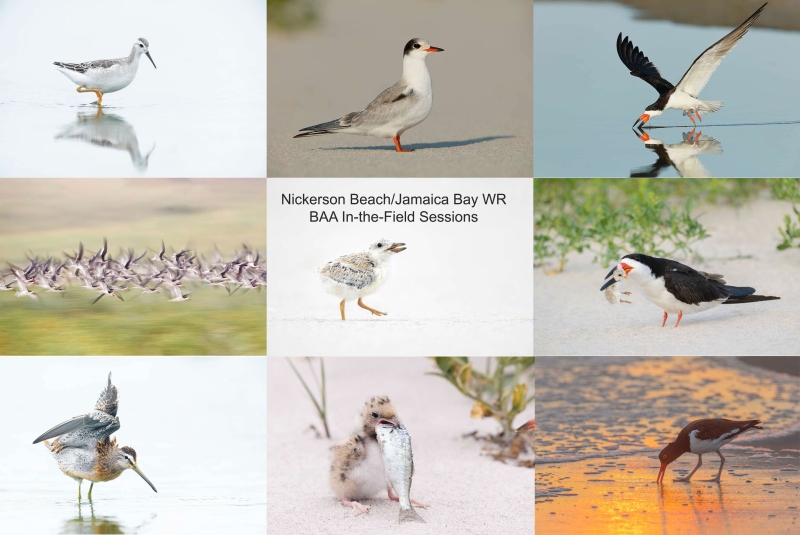
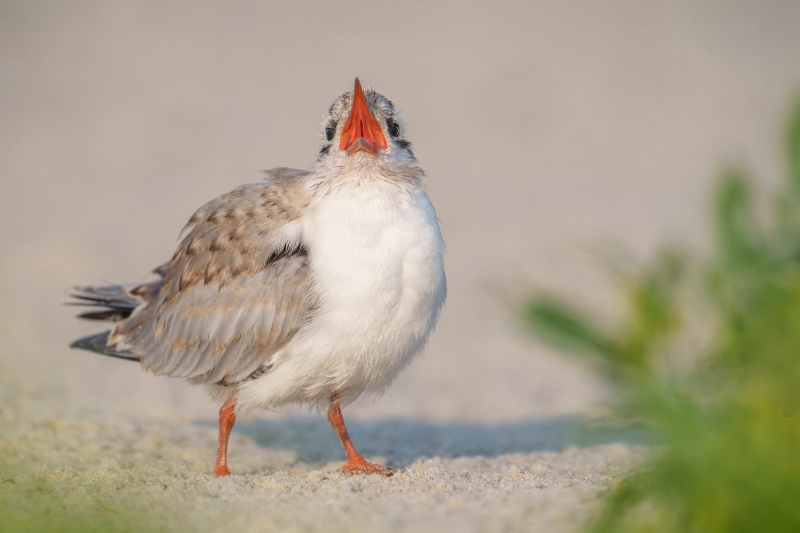
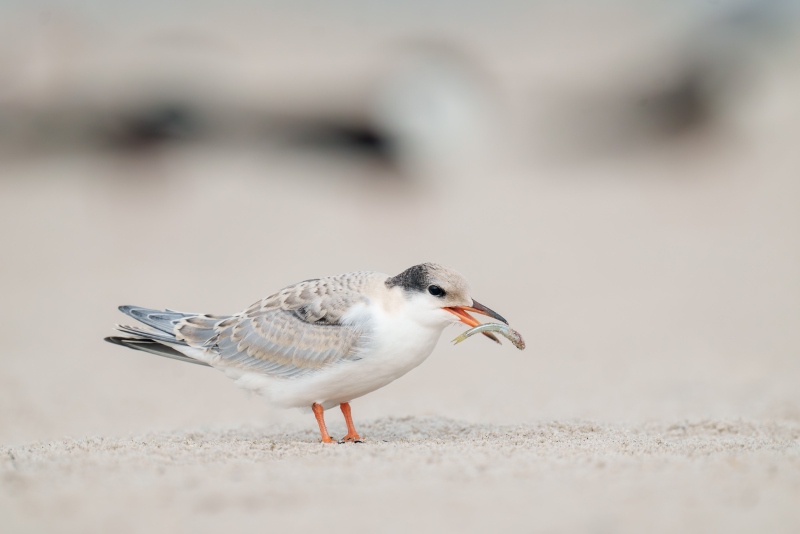
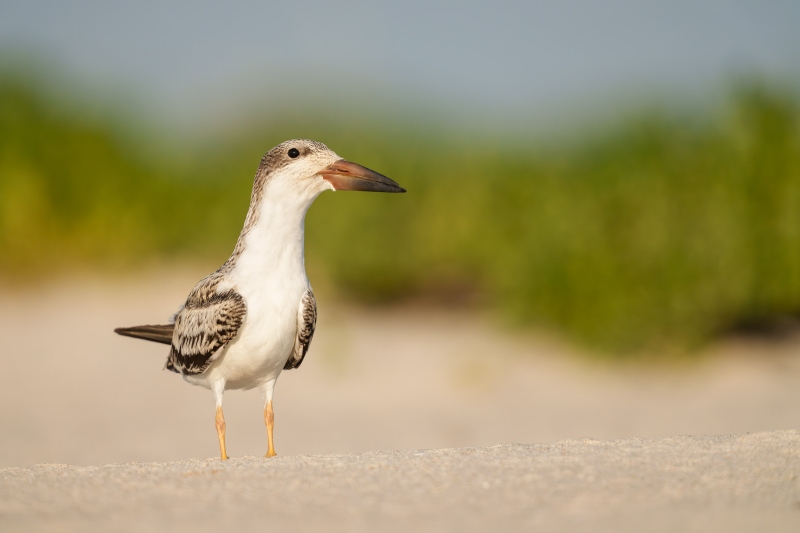






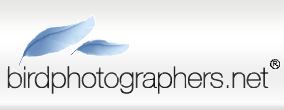


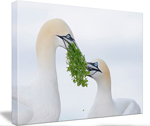



Artie, I have mixed feelings; when I viewed the smaller version, my first take was that I would have eliminated them. When I clicked on the image to view its larger version, my perspective was different; I still don’t know that they added a lot to the image other than environmental perspective and depth, but they weren’t the intrusive element I initially thought they were. In the end, I would tend toward keeping them.
Thanks for your thoughtful comment, John. I guess that I kept them because I thought it might be too sterile without them.
with love, artie
Yes, I would have eliminated them completely from image #2 because I find them very distracting.
Thanks, Pat. I am still undecided.
with love, artie